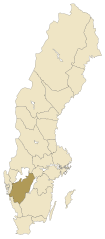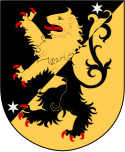Västergötland
| ||||
| ||||
| ||||
| Państwo | ||||
|---|---|---|---|---|
| Kraj | Götaland | |||
| Powierzchnia | 16 676 km² | |||
| Populacja (2013) • liczba ludności | 1 279 030[1] | |||
| • gęstość | 76,7 os./km² | |||
Położenie na mapie | ||||
| 58°30′N 13°00′E/58,500000 13,000000 | ||||
Västergötland - jedna z dwudziestu pięciu tradycyjnych, historycznych prowincji Szwecji. Największe miasto prowincji, Göteborg, jest zamieszkane przez ponad pół miliona osób, a cała prowincja zajmuje powierzchnię 16 696 km2.
Västergötland położony jest w południowo-zachodniej części Szwecji, w Götaland. Obejmuje cztery współczesne regiony administracyjne – Västra Götaland, Jönköping, Halland oraz Örebro.
W Västergötland jest w użyciu lokalny dialekt języka szwedzkiego, nazywany västgötska.
Przypisy
- ↑ Statistiska centralbyrån: Folkmängd i landskapen den 31 december 2013 (szw.). [dostęp 2014-10-16].
Media użyte na tej stronie
Autor: Lapplänning (highlighting by Lokal_Profil), Licencja: CC BY-SA 2.5
Location of the Swedish province of Västergötland
(c) Lokal_Profil, CC BY-SA 2.5
This coat of arms was drawn based on its blazon which – being a written description – is free from copyright. Any illustration conforming with the blazon of the arms is considered to be heraldically correct. Thus several different artistic interpretations of the same coat of arms can exist. The design officially used by the armiger is likely protected by copyright, in which case it cannot be used here.
Individual representations of a coat of arms, drawn from a blazon, may have a copyright belonging to the artist, but are not necessarily derivative works.
Swallow-tailed flag used between the reign of Gustav I of Sweden until c. 1650, when it was succeeded by a triple-tailed flag.
Great coat of arms of Sweden





